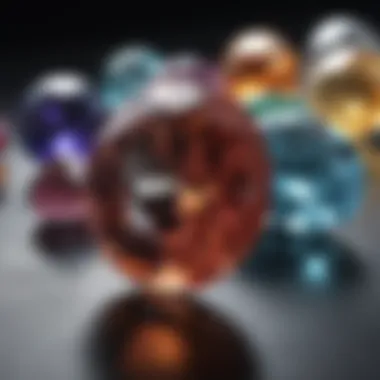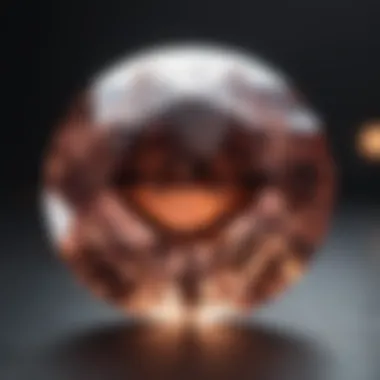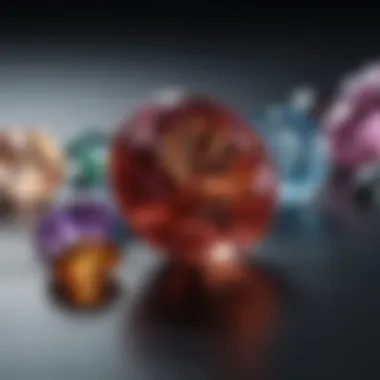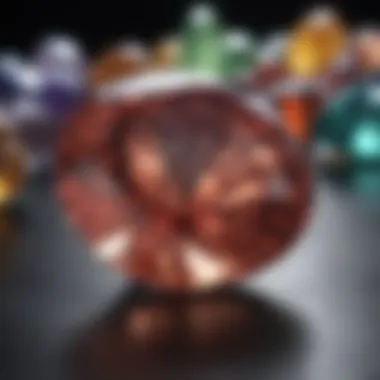Unveiling the Impact of Carat Size Comparison on Gemstone Value and Visual Appeal


Overview of Gemstones and Minerals
Gemstones and minerals have long held a significant place in human history, dating back to ancient civilizations where they were valued for their rarity and beauty. The usage of gemstones and minerals has not solely been confined to adornment; they have also played essential roles in cultural practices and belief systems. From being talismans for protection to symbols of status and wealth, gemstones and minerals have woven themselves into the fabric of society worldwide. Their importance transcends mere aesthetic value, reflecting deeper meanings and connections within various cultures.
Gemstone Formation and Properties
The formation of gemstones is a fascinating process that occurs deep within the Earth's crust, under immense pressure and heat over millions of years. This intense environment leads to the creation of crystals that eventually develop into the dazzling gemstones we admire. Gemstones possess distinct properties that set them apart from common minerals. These properties include their color, hardness, and luster, which collectively contribute to their allure and value. Their unique composition and crystal structures give each gemstone its individual characteristics and visual appeal.
Types of Gemstones
Gemstones are broadly classified into two categories: precious and semi-precious. Precious gemstones, such as diamonds, rubies, emeralds, and sapphires, are highly sought after for their rarity and exceptional beauty. In contrast, semi-precious gemstones encompass a wide range of varieties like amethyst, citrine, and turquoise, offering diverse options for jewelry and ornamental purposes. Beyond the conventional distinctions, there exist exotic and rare gemstones that captivate collectors and enthusiasts with their scarcity and distinctive properties, adding a sense of exclusivity to the world of gemstones.
Identifying and Evaluating Gemstones
Evaluating the value of a gemstone involves considering various factors that affect its overall worth. These factors include color intensity, clarity, cut quality, and carat weight, with each playing a crucial role in determining the gemstone's market value. Utilizing specialized techniques and instruments, gemologists can identify and grade gemstones based on these criteria, providing valuable insights into their quality and authenticity. By understanding the intricate nuances of gemstone evaluation, collectors and buyers can make informed decisions when acquiring these precious stones for their collections.
Caring for Gemstones
Proper care and maintenance are essential for preserving the beauty and lifespan of gemstones. Regular cleaning using gentle techniques and storing gemstones in suitable conditions can prevent damage and maintain their visual appeal. Avoiding common mistakes, such as exposing gemstones to harsh chemicals or extreme temperatures, is crucial in safeguarding their longevity and brilliance. Additionally, tailoring maintenance practices to specific gem types, whether diamonds, pearls, or emeralds, ensures their durability and sparkle for generations to come.
Introduction.
In the vast realm of precious gems and minerals, the concept of carat size serves as a fundamental criterion determining the value and allure of gemstones. This paramount metric, often misunderstood by laymen, plays a pivotal role in the gemstone industry and among collectors and enthusiasts.


Delving into the intricate world of gemology, understanding carat size provides a gateway to comprehending the intrinsic worth and visual impact of gemstones. In this comprehensive guide, we embark on a journey to unravel the importance of carat size comparison in Gemstones, shedding light on its nuanced relevance in evaluating and appreciating these precious treasures.
With a keen focus on elucidating the intricate nuances of carat size comparisons in gemstones, we aim to equip gemstone connoisseurs, collectors, and enthusiasts with the knowledge necessary to navigate the complexities of gem appraisal and acquisition. By elucidating the crucial role carat size plays in assessing gemstone quality, we empower our readers to make informed decisions and enhance their understanding of the fascinating world of gems and jewelry.
Exploring the relevance of carat size comparisons in gemstones entails a multifaceted approach encompassing historical significance, craftsmanship intricacies, and market dynamics. Through a detailed exploration of this topic, we unveil the subtleties that distinguish varying carat sizes and their impact on gemstone aesthetics and worth, offering invaluable insights for those passionate about gemology and jewelry design.
Our aim is to demystify the significance of carat size in gemstones, elevating the discourse surrounding gemstone valuation and appreciation. By comprehensively examining the implications of carat size comparisons, we seek to enrich the knowledge base of our discerning readers, fostering a deeper understanding of the factors that contribute to the allure and value of these exquisite natural creations.
The Importance of Carat Size in Gemstones
Gemstones hold a captivating allure, enticing gemstone enthusiasts and collectors with their radiant beauty and timeless appeal. Within the realm of gemstones, the carat size plays a pivotal role, serving as a key determinant of a gemstone's value and desirability. Understanding carat size in gemstones is essential for those seeking to appreciate and evaluate these precious creations accurately.
Defining Carat Size
To grasp the concept of carat size in gemstones, one must first comprehend the measurement unit itself. Carat size refers to the weight of a gemstone and is often a reflection of its size. Contrary to common belief, carat does not directly indicate the dimensions of a gemstone but rather its mass. In the context of gemstones, a metric carat is equivalent to 200 milligrams, offering a precise measure for comparison across different gemstone types.
Factors Influencing Carat Size Comparison
Various factors influence how carat size is perceived and compared among different gemstones. The density and specific gravity of a gemstone significantly impact its carat weight, affecting how substantial or delicate a gemstone of a particular carat size appears. Additionally, the cut and shape of a gemstone can influence its perceived size, with certain cuts accentuating the carat weight more effectively. Understanding these factors is crucial when evaluating and comparing gemstones based on their carat sizes.
Value Considerations based on Carat Size
The relationship between carat size and value in gemstones is multifaceted, encompassing not only the inherent rarity of larger carat stones but also the craftsmanship and quality of the gemstone. While larger carat gemstones tend to command higher prices due to their scarcity, other factors such as color, clarity, and cut also contribute significantly to a gemstone's overall value. It is essential for gemstone enthusiasts and collectors to consider these nuances when assessing the value of a gemstone based on its carat size, ensuring a more comprehensive understanding of its worth and appeal.
Popular Gemstones and Their Carat Sizes


In the realm of gemstones, understanding and comparing carat sizes are paramount activities for gemstone enthusiasts and collectors. The significance of popular gemstones and their carat sizes lies in the distinctive characteristics that define each gemstone variant. Whether it be the brilliant sparkle of diamonds, the rich hues of sapphires, or the mesmerizing green of emeralds, each gemstone's carat size plays a crucial role in determining its value and visual appeal. Consumers often seek to strike a harmonious balance between carat size and quality when selecting their desired gemstones, thereby highlighting the importance of this topic in the world of gemology.
Diamonds
Small Carat Diamonds
Small carat diamonds hold a special place in the realm of gemstones, offering a delicate yet radiant appearance. Their petite size allows for versatility in jewelry design, making them a popular choice for intricate and elegant pieces. Despite their modest size, small carat diamonds exhibit exceptional brilliance and clarity, making them a desirable option for those seeking understated elegance. However, it is essential to note that the smaller carat size may impact the perceived value of the diamond, particularly concerning traditional beliefs associating larger carat weights with higher worth.
Medium Carat Diamonds
Medium carat diamonds strike a balance between subtlety and presence, making them a favored choice for individuals looking for a blend of sophistication and allure. These diamonds offer a versatile range of design possibilities, suitable for both everyday wear and special occasions. The key characteristic of medium carat diamonds lies in their ability to capture and reflect light effectively, creating a mesmerizing sparkle that draws attention without being overpowering. While medium carat diamonds exude elegance, their value may vary based on other factors such as cut, color, and clarity.
Large Carat Diamonds
Large carat diamonds embody opulence and luxury, commanding attention with their impressive size and brilliance. These diamonds are synonymous with grandeur and prestige, often adorning significant pieces of jewelry meant for lavish events. The key characteristic of large carat diamonds is their undeniable presence, capable of captivating onlookers with their dazzling sparkle and size. However, it is essential to consider that large carat diamonds may come with a heftier price tag and necessitate careful consideration of other quality factors to ensure a balanced and valuable purchase.
Sapphires
Comparing Carat Sizes in Blue Sapphires
When exploring carat sizes in blue sapphires, one delves into a world of radiant hues and enchanting depths. Blue sapphires, known for their intense and mesmerizing blue color, present a spectrum of carat sizes that cater to varied preferences and budgets. Comparing carat sizes in blue sapphires allows enthusiasts to understand how size impacts the overall allure and value of the gemstone. While larger carat sizes may showcase a more profound color saturation, smaller carat sapphires possess their unique charm and elegance, making them an accessible choice for diverse jewelry designs.
Variations in Carat Size for Fancy Sapphires


The diversity of fancy sapphires extends to their carat sizes, offering a mosaic of options for those seeking distinctive and unconventional gemstones. Variations in carat size for fancy sapphires create a playground for creativity, allowing designers to experiment with different sizes to achieve their desired aesthetic. While larger carat fancy sapphires may make a bold statement, smaller carat variations enable delicate and intricate designs, catering to a broad audience with varying style preferences. Understanding the nuances of carat sizes in fancy sapphires enables collectors and designers to curate pieces that reflect individuality and unique taste.
Emeralds
Assessing Carat Sizes in Emeralds
Emeralds, renowned for their lush green hue and mesmerizing clarity, present a captivating range of carat sizes for enthusiasts to explore. Assessing carat sizes in emeralds involves considering the interplay between size, color intensity, and clarity to determine the gemstone's overall appeal. Whether opting for a modest carat size for a subtle touch of green or indulging in a larger carat emerald for a statement piece, each carat size brings forth unique characteristics that contribute to the emerald's allure. The key to assessing carat sizes in emeralds lies in understanding how size influences the stone's saturation and presence, ultimately guiding consumers in selecting the ideal emerald for their jewelry creations.
Visual Impact and Perception based on Carat Size
In the realm of gemstones, the aspect of carat size plays a pivotal role in determining not only the value but also the visual impact and overall perception of a gemstone. The visual impact of a gemstone is profoundly influenced by its carat size, which directly relates to the stone's size and weight. Larger carat sizes often command attention with their brilliance and presence, drawing the eye and exuding a sense of grandeur and luxury. On the other hand, smaller carat sizes may offer a subtle elegance, captivating with their delicate beauty and intricacies. The perception of a gemstone's value and desirability is intrinsically tied to its carat size, as larger carat sizes are commonly associated with rarity and prestige, while smaller carat sizes might appeal to those inclined towards understated sophistication.
When considering the visual impact and perception based on carat size, it is essential to account for the interplay between carat size, gemstone type, and setting. Different gemstones exhibit varying levels of brilliance and color saturation, which can be magnified or subdued by the carat size. For instance, in diamonds, a larger carat size can enhance the sparkle and fire of the gem, intensifying its allure and creating a mesmerizing play of light. Conversely, in certain colored gemstones like sapphires and emeralds, the carat size can influence the depth of color and transparency, affecting the overall aesthetic appeal.
Moreover, the setting of a gemstone, whether in a ring, necklace, or earrings, can further accentuate the visual impact of its carat size. The design and craftsmanship of the jewelry piece play a significant role in highlighting the gemstone's size and enhancing its presence. A well-executed setting can showcase the gemstone in the most flattering light, optimizing its visual impact and ensuring that its carat size is fully appreciated. By understanding the nuances of visual impact and perception based on carat size, enthusiasts, collectors, and jewelry designers can make informed decisions when selecting gemstones, ultimately elevating the overall experience of admiring and wearing these exquisite creations.
Choosing the Right Carat Size for Your Gemstone
In the realm of precious gemstones, selecting the appropriate carat size is a meticulous process that requires careful consideration. When choosing the right carat size for your gemstone, one must delve into various factors that influence the gem's visual appeal, value, and overall aesthetics. This crucial decision is not solely about opting for the biggest carat size available but rather about striking a harmonious balance between size and quality. It involves a nuanced understanding of how carat size affects the gemstone's brilliance, color saturation, and overall presence.
One key element to consider when deciding on the ideal carat size for your gemstone is the cut of the gem. Different cuts interact with light in unique ways, affecting how the carat size is perceived. For instance, a well-cut gemstone can make a smaller carat size appear more substantial by enhancing its sparkle and fire. On the other hand, a poorly cut gem may undermine the visual impact of a larger carat size due to light leakage or uneven proportions. Therefore, when making this decision, it is imperative to not only focus on the carat size itself but also consider how it complements the gem's cut to maximize its beauty.
Another crucial aspect in choosing the right carat size for your gemstone is personal style and preference. While some may prefer a modest carat size that exudes understated elegance and sophistication, others might gravitate towards larger carats for a bolder, more statement look. Understanding your style preferences and the occasions you intend to wear the gemstone for is paramount in making an informed decision. Moreover, considering the size of other jewelry pieces you plan to wear alongside the gemstone can also guide you in selecting a carat size that harmonizes with your overall jewelry ensemble.
Furthermore, budget plays a significant role in determining the appropriate carat size for your gemstone. It is essential to strike a balance between carat size and quality within your set budget constraints. Opting for a slightly smaller carat size with higher clarity and color grades may enhance the gem's overall beauty and prestige compared to a larger carat size with visible inclusions or color tints. Therefore, assessing your budget and prioritizing quality over sheer carat weight can lead to a more satisfying and enduring gemstone acquisition.
Conclusion
Delving into this topic has revealed that carat size is just one piece of the puzzle when it comes to selecting the perfect gemstone. The nuances in how different gemstones carry their carat weight, the variations in visual impact based on carat size, and the emotional and aesthetic significance attached to larger or smaller stones have all been explored in depth. By understanding the relationship between carat size and gemstone value, readers are better equipped to make informed decisions when it comes to acquiring or appreciating these precious gems.
Moreover, the discussion on carat size in gemstones has emphasized the importance of individual preference and personal style in choosing the right gemstone. While some may gravitate towards larger carat sizes for the grandeur they exude, others might appreciate the subtle elegance of smaller stones. This section has underscored the significance of considering not only the financial aspects but also the emotional and symbolic value attached to gemstones, making the selection process a nuanced and multi-faceted endeavor.







